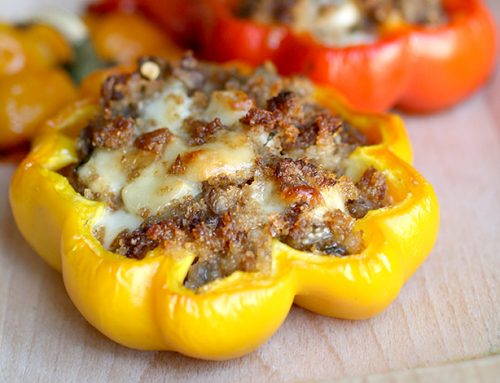Here’s the cherry for your cake :-) And also for mine… as I have always postponed the studying of the cheese chapter, first of all because I had a poor comprehension of it, and then I have never found someone very reliable, who knew this fascinating subject deeply enough, and shared the need of awareness, the respect for animals and all the rest you know yet.
Moreover, I had a hesitation, concerning the nutritional biotherapy, that I always bear in mind, as you know and I will talk about of later.
To clear the situation, last June a so called Stefano Mariotti sent me an e-mail to let me know that he is setting up a topic on his website, Qualeformaggio. Strangely, I never came across it – big mistake, it is a must to the conscious chef (since then, I was never came across to it – big mistake, it is a must to the conscious chef), together with four other bloggers, (Agostina from Pane, burro e marmellata, Elisa from Kitty’s Kitchen, Laura from La Signora Laura, and Sarah from ).
In his plan, each blogger will cook an ad hoc recipe, weekly, with the cheese he will provide to send them. In the e-mail, he asks me if I am interested to join the team.
My answer is… a very long list of questions about the kind of cheese we would have to “transform”, how are the animals bred, from which the milk comes and so on. Stefano, instead of being discouraged, seizes the opportunities to pass on to me his knowledge, I hope to share with you gradually through this topic; and this was useless, as in the mean time I read this page (enough on its own), this and this, and I was just changed my mind about my original rule “You won’t write on any other blog then yours”.
The only remaining problem I mentioned some lines above, is that the nutritional biotherapy takes cheese with a grain of salt. It considers them precious, but potentially dangerous, and in any case they have to be used with caution (obviously, we are talking about the intake by person suffering from some disease; who has a healthy liver and a regular metabolism is allow to eat them more frequently, but without exaggerating).
The cheeses are complete foods, very reach in nutrients; in fact (says the big book) “in the farmer’s culture of the past, [the cheeses] were eaten when the work was very hard (often it was the summer season) and the sweating was heavy. The farmer was able to work hard all day long, eating only bread and cheese”. Moreover, in winter time, home were not very well heated, and the energetic power from cheese was useful to cope with cold.
They contain tyramin, parent compound of adrenalin, noradrenalin and other neurotransmitters, that arises the waking; calcitonin, that arouses the Central Nervous System excitability; and the serotonin, that has a relaxing effect in the milk, but it is inhibited by the curdle.
Finally, it consists of food appropriate for organisms on the rise (better, if they are not eaten for dinner, as they could harm the sleep; on the other hand, it is perfect for night workers, who have to be awake), or during the teething period, as they enhance and improve the teeth formation.
They are useful during the pregnancy and the breast-feeding, and helpful to students due to their high phosphorus supply and the suprarenal stimulation.
Moreover, cooked in an appropriate way, they are able to activate gastric digestive processes, due to the left-over natural curdle they contain; the prof is that popular tradition was used to end the meal with a taste of cheese (then substituted by coffee).
The complicated side is how to handle their fat content and the high percentage of mineral salts, useful in some circumstances (diarrhea, general debility, low blood pressure, dehydration), but very harmful to high-blood pressure or heart-diseases sufferers, to epileptics or to the sufferers from neurovegetative dystonia. Moreover, it could cause people headache and constipation, women androgenisation, and predisposes to renal calculosis and to nervous depression.
That is why the recipes I will post on Stefano’s website will be basic and I will use cheeses in small amount. I urge you to eat them rarely, alway keep in mind to eat them only if you belong to one of the categories above, or if you are absolutely healthy and you need an authentic energy bomb.
Done! Today, Stefano has announced the end of the blogger-silence, decreed not to spoil the surprise; finally, I can introduce the topic I will write at the same time here on the Pasto Nudo, where shortly, I will speak about the cheeses one by one, every time I will use them in the recipes I post on Quale Formaggio (here it is the link of the appropriate page: the first recipe is by Elisa, from Kitty’s kitchen, a beautiful dish of thin slices of zucchini and a very special ricotta I will speak about shortly).
All the cheeses we will use come from animals put out to pasture (in summer season), possibly in high mountain and wandering in the streets of the stock-rearing, fed without fodder, made from the milk by an individual farmer, and transformed just milked. The milk used is mostly raw, therefore not pasteurized: the fresh-drawn milk has a temperature of 37°-38°C, in few minutes goes down to 30-32°C, and to make cheese it is heated up a little bit (rarely, above 42-44°C), keeping “stress” to a minimum, compared to the industrial production processes, where the raw material is refrigerated at an intermediate phase (4°C) before the cheese-making process. That’s it, and it is something considerable.
However, even when the milk is pasteurized, it is heated up to 74°C for few seconds, so that it maintains almost its nutritional properties (to be precise, there is a “high” pasteurization to 75-85°C for 2-3 minutes, and one “low”, less frequently used, to 60-65°C for 30 minutes).
The grass-fed animals (that eat a mixture of grass, flowers and leaves) produce a scented and healthy milk, as the vegetables they eat are full of terpenes (volatile and very much scented compounds, that let vegetables to be able to defend from parasites or to activate the pollinator insects – in simple terms, scents :-)); every grass transfers different nutritional contents to the milk, and more variety the animal can find, the more their milk (and, consequently, cheeses and the meat) is rich in flavorings and is nourishing.
Who is feeling like going deeply into the topic, can have a look to this interesting article, posted on Porthos, that highlights the impressive differences between the good extensive zootechny and the intensive or industrial zootechny, a four-hand article by Stefano e Michele Corti, teacher of zootechnical and animal-breeding systems at the University of Milan.
In the intensive livestock farming, they eat – as the best option – mainly grass, lacking of terpenes. In the worst scenario, unfortunately, animals eat mainly fodder, a mixture made by different components, based on corn and soy sorghum (a certain percentage could be gmo); but, there is also something worst and it is the unifeed, that is to say unique feed, a single dish mixture of five ingredients (cereals, vegetable proteins and silage), blended together and dispensed once a day, every single day, for the animal’s entire life, without any chance for it to select what it would like to eat. Only the high-production intensive livestock farming makes use of the unifeed.
Finally, the base philosophy is the one you know, and that goes far beyond the biological certification (do you remember the article about the Bottega Liberati?): if we want to feed in a truly healthy way, if we want the food to transmit to us lively and real energy, we must feed on products from animals that have had a happy life and as near as possible to the natural one. How can we imagine to keep ourselves healthy, having meat, eggs and milk (and delicious derivatives), coming from depressed, frightened and imprisoned animals?
It is absolutely necessary to raise our level of consciousness, and to start investigate deeper what we eat. Stop to blindfold, stop to the childish distraction (do not waste your time with annoying information, stop reading, watch the fiction where the main characters are rich and you can virtually live their life, so that it seems useless to make yours better!).
I know, it is much more difficult. But I have to confess a strange thing, I am finding out that much more enjoyable. The truth is definitely more cool than the lies. and also healthier.
Someone I loved very much tried to tell us, about thirty years ago :-)





Scrivi un commento